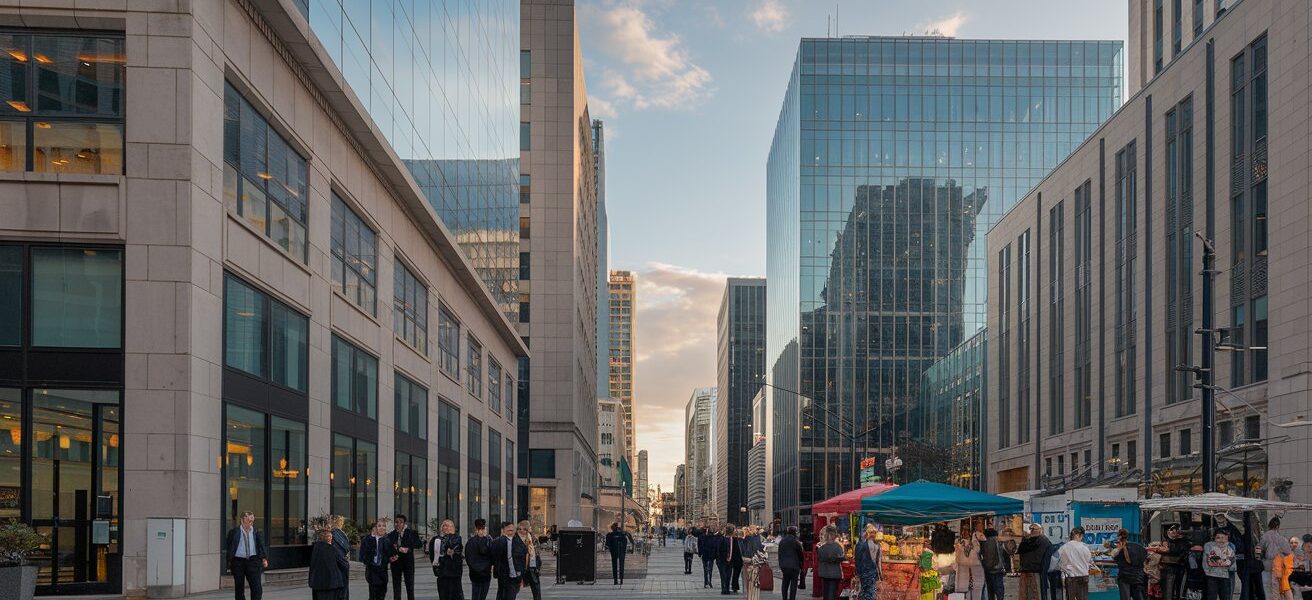A business district is one of the crucial components of the socio-constructing area since it contains the focus of business and economic activities in the given city. Normally lying within city or town centre business areas are essential for development of business, employment and commerce. It is whether the over scale business district of NYC’s financial center or a micro business district of a developing town, the centrality of the business district cannot be overemphasized in the economy.
What is a Business District?
A business district therefore may be defined as an area found within a city or town where a relatively high level of business takings is witnessed. This district encompasses corporate business facilities, banking and financial institutions, business shops, eateries, guest houses and other commerce. Mostly it is well planned, concentrated with commercial activities, and built to bear intensive traffic of both pedestrians and automobiles.
Types of Business Districts
Not all business zones are created in the same way. There are various types of business districts that serve different purposes and cater to specific industries:
-
CBD which refers to Central Business District.
Central business district is usually the most significant kind of business district located in large metropolitan areas. This is the major business district where the company headquarters, banks and quality shopping firms are situated. CBDs typically make use of high-rises, extensive commercialization and are well-connected by transport networks.
-
Industrial Business District
Unlike a CBD, an IBD has industrial uses such as manufacturing, warehousing, and distribution. Such districts would most often surround areas that are close to cities or regions that are directly linked to transport such as highways or a seaport. Not as flashy as CBDs, industrial business districts are important for their contribution to production and distribution.
-
Retail Business District
A retail business district is therefore a specific area that mainly comprises of outlets or stores accessible to the buyer. These districts are dominated with shopping centers, boutique shops, restaurants, and entertainment facilities. For instance, there is Rodeo Drive in Beverly Hills or Fifth Avenue in New York City.
This paper defines features of a business district as follows:
While the type and scale of a business district can vary, certain characteristics are common across most districts:
-
Large numbers of businesses
Another important characteristic of a business district is the type of activities where there is density of commercial facilities. This includes but not limited to; office spaces, corporate offices, business and retail shops, restaurants, and firms that offer services. This makes the environment so vibrant and its flexibility suitable for the growth of the economy.
-
Accessibility
Availability is therefore one major factor that will determine success in a business district. Almost every business district has its main office situated in the heart of a city or town, close to public transport systems, principal roads, and interstates. This makes it easy for employees, customers, and business partners to commute and access all the facilities within the district.
-
Infrastructure and Amenities
Several structures in business districts are well developed including roads, public transport as well as communication facilities. Further, comfort in their ‘business services’ along with restaurants, hotels, conference centers and parks are beneficial to the businesses and employees as well. Stable telecommunications lines, responsive utilities, and favorable mobile connection are also requisites of a functional business district.
Why Business Districts Are Unique
Organizational territories remain vital in determining the economic growth and physical layout of cities. Here’s why they are so important:
-
Economic Growth
It is important for business districts to drive the economic productivity of cities. and they enhance trade, investments and innovation through the centralization of the business hub. This has seen some of the city and region’s large corporations and other large financial institutions attract both local and foreign investments hence bolstering the overall economic growth of the city and the region.
-
Job Creation
Business districts are also the largest source of employment. There is a large number of vacancies available; starting from working in the offices or shops and ending with eating, as well as staying, establishments. In crowded business areas for instance thousands of people are employed within a small area of few square miles requirements for services are felt hence increases local employment.
-
Increased Property Values
When businesses and amenities are established in a business district they may cause an increase in property values. It is renowned that commercial real estate in such districts is usually lucrative because of market access, location and traffic. For property owners, increased demand leads to advantageous for businesses also means higher revenues and higher rent.
The Strategies That Every Business Person in a Business District Should Adopt
There is a lot of competition in business districts which may make it a hub of many challenges but at the same time could be very rewarding due to high traffic. But the fact is that, if the business has formulated a correct strategy, it is capable of flourish in such environments. Here are some practical tips:
-
Use Location to Establish a Great Brand Image
Of all the benefits of operating in a business district, the first one is the visibility that businesses get from operating in the area. They should take the best opportunity of being situated in strategic areas always working on the recognition and the amount of people that may patronize their businesses. High visibility also results into contact opportunities with other businessmen and business people in the same region, which may Crane and produce business relations or business associations.
-
Understand the Market
A business district can involve a significantly diverse number of businesses and customers. In its turn, to achieve the goals a proper evaluation of the certain kind of market, which functions in the given district, is vital. Market analysis is important for target customers’ definition, competitors’ analysis, and market demand measuring. It enables them to better understand the needs of the district’s clients so as to fit the appropriate product or service.
Looking at the Future of Business Districts
Just like cities change over time so does business districts. In recent years, several trends have emerged that are shaping the future of business districts around the world:
-
Smart City Initiatives
Smart city solutions are being implemented in different cities to try and transform business areas into smarter ones. From intelligent transportation systems to energy saving structures these implementations aim at enhancing the general performance of business areas and environments that facilitate commerce and habitation.
-
Sustainability and Green Spaces
Urban sustainability has become an important trend and this notion is also embodied in business districts. More new generation business zones are now planning and including greenery like a park, terrace, or open area to freshen up the employees’ zone and decrease the city’s carbon impression.
-
Remote Working and Open Spaces
COVID 19 has changed the trends, and flexibility of working distant pushed the evolution of business districts. With increased cases of organizations shifting to work from home or a combination of on-site and remote working from the office, there are changes afoot in workplace design. Office sharing, and shared offices solutions are being adopted to help business reduce their expenses on space but still have their offices in the district.
Conclusion
The business district is not only a significant core of the commercial and spiritual life of any city but also a part of the economic framework. The social and economical development and security of the citizens,business districts contribute to modern life in tremendously as they a provide place for economical growth,job creation,commercial enterprise among other roles. Over all, operating a business in a business zone has its advantages and disadvantage to the business.





